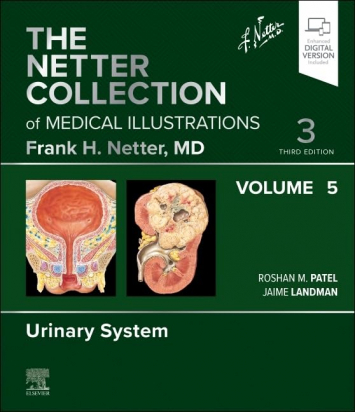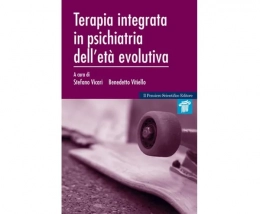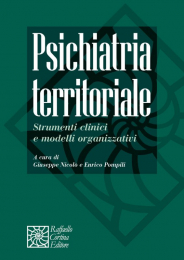Non ci sono recensioni
DA SCONTARE
| Description: Offering a concise, highly visual approach to the basic science and clinical pathology of the urinary system, this updated volume in The Netter Collection of Medical Illustrations (the CIBA "Green Books") contains unparalleled didactic illustrations reflecting the latest medical knowledge. Revised by Drs. Jaime Landman and Roshan M. Patel, Urinary System, Volume 5 integrates core concepts of anatomy, physiology, and other basic sciences with common clinical correlates across health, medical, and surgical disciplines. Classic Netter art, updated and new illustrations, and modern imaging continue to bring medical concepts to life and make this timeless work an essential resource for students, clinicians, and educators. |
| Features: |
|
SECTION 1 ANATOMY OF THE URINARY TRACT
1.1 Kidney: Position and Relations (Anterior Views)
1.2 Kidney: Position and Relations (Posterior Views)
1.3 Kidney: Position and Relations (Transverse Sections)
1.4 Kidney: Gross Structure
1.5 Renal Fascia
1.6 Ureters: Position, Relations, Gross Structure
1.7 Bladder: Position, Relations, Gross Structure (Male)
1.8 Bladder: Position, Relations, Gross Structure (Female)
1.9 Bladder: Position, Relations, Gross Structure (Coronal Cross Sections)
1.10 Renal Vasculature: Renal Artery and Vein in Situ
1.11 Renal Vasculature: Renal Artery Segmental Branches and Intrarenal Arteries
1.12 Renal Vasculature: Variations in Renal Artery and Vein
1.13 Vasculature of Ureters and Bladder
1.14 Innervation of Kidneys, Ureters, and Bladder
1.15 Innervation Pathways of the Kidneys and Upper Ureter
1.16 Innervation Pathways of the Ureter and Bladder
1.17 Lymphatics of Urinary System
1.18 Overview of the Nephron
1.19 Renal Microvasculature
1.20 Glomerulus: Structure and Histology
1.21 Glomerulus: Fine Structure
1.22 Glomerulus: Electron Microscopy
1.23 Proximal Tubule
1.24 Thin Limb
1.25 Distal Tubule
1.26 Collecting Duct
1.27 Renal Pelvis, Ureter, and Bladder
SECTION 2 NORMAL AND ABNORMAL DEVELOPMENT
2.1 Development of Kidney
2.2 Development of Kidney: Nephron Formation
2.3 Development of Bladder and Ureter: Formation of Cloaca
2.4 Development of Bladder and Ureter: Septation Incorporation of Ureters, and Maturation
2.5 Kidney Ascent and Ectopia: Normal Kidney Ascent and Pelvic Kidney
2.6 Renal Ascent and Ectopia: Thoracic and Crossed Ectopic Kidney
2.7 Renal Rotation and Malrotation
2.8 Anomalies in Number of Kidneys: Bilateral Renal Agenesis
2.9 Anomalies in Number of Kidneys: Unilateral Renal Agenesis
2.10 Anomalies in Number of Kidneys: Supernumerary Kidney
2.11 Renal Fusion
2.12 Renal Dysplasia
2.13 Renal Hypoplasia
2.14 Simple Cysts: Bosniak Classification of Cystic Kidney Masses
2.15 Simple Cysts: Bosniak Classification of Kidney Cysts
2.16 Polycystic Kidney Disease: Gross Appearance
2.17 Polycystic Kidney Disease: Radiographic Findings
2.18 Medullary Sponge Kidney
2.19 Nephronophthisis/Medullary Cystic Kidney Disease Complex
2.20 Retrocaval Ureter: Radiographic Findings and Laparoscopic Repair
2.21 Retrocaval Ureter: Normal Development of the Inferior Vena Cava
2.22 Vesicoureteral Reflux: Mechanism and Grading
2.23 Vesicoureteral Reflux: Voiding Cystourethrograms
2.24 Ureteral Duplication: Complete
2.25 Ureteral Duplication: Incomplete
2.26 Ectopic Ureter
2.27 Ureterocele: Gross and Fine Appearance
2.28 Ureterocele: Radiographic Findings
2.29 Prune Belly Syndrome: Appearance of Abdominal Wall
2.30 Prune Belly Syndrome: Appearance of Kidneys, Ureters, and Bladder
2.31 Epispadias Exstrophy Complex
2.32 Epispadias Exstrophy Complex: Bladder Exstrophy
2.33 Bladder Duplication and Septation
2.34 Anomalies of the Urachus
2.35 Posterior Urethral Valves: Congenital Bladder Outlet Obstruction
2.36 Posterior Urethral Valves: Radiographic Findings
SECTION 3 PHYSIOLOGY
3.1 Basic Functions and Homeostasis
3.2 Clearance and Renal Plasma Flow
3.3 Glomerular Filtration Rate
3.4 Glomerular Filtration Rate: Calculation
3.5 Secretion and Reabsorption: Tubular Reabsorption and Saturation Kinetics
3.6 Secretion and Reabsorption: Fractional Excretion (Clearance Ratios)
3.7 Renal Handling of Sodium and Chloride: Nephron Sites of Sodium Reabsorption
3.8 Renal Handling of Sodium and Chloride: Response to Extracellular Fluid Contraction
3.9 Renal Handling of Sodium and Chloride: Response to Extracellular Fluid Expansion
3.10 Renal Handling of Potassium
3.11 Renal Handling of Calcium, Phosphate, and Magnesium
3.12 Countercurrent Multiplication: Model of the Countercurrent Multiplier
3.13 Countercurrent Multiplication: Models to Demonstrate Principle of Countercurrent Exchange System of Vasa Recta in Minimizing Dissipation of Medullary Osmotic Gradient
3.14 Urine Concentration and Dilution: Long-Looped Nephron (ADH Present)
3.15 Urine Concentration and Dilution: Long-Looped Nephron (ADH Absent)
3.16 Antidiuretic Hormone
3.17 Tubuloglomerular Feedback and Modulation of Renin Release
3.18 Tubuloglomerular Feedback and Renin-Angiotensin-Aldosterone System
3.19 Acid-Base Balance: Roles of Chemical Buffers, Lungs, and Kidneys in Acid-Base Handling
3.20 Acid-Base Balance: Renal Bicarbonate Reabsorption
3.22 Acid-Base Balance: Acidosis and Alkalosis
3.23 Additional Functions: Erythropoiesis and Vitamin D
3.24 Renal Tubular Acidosis: Proximal
3.25 Renal Tubular Acidosis: Classic Distal
3.26 Nephrogenic Diabetes Insipidus
3.27 Nephrogenic Diabetes Insipidus: Major Causes and Symptoms
SECTION 4 KIDNEY DISEASES
4.1 Overview of Acute Kidney Injury: Causes
4.2 Overview of Acute Kidney Injury: Possible Urine Sediment Findings
4.3 Acute Tubular Necrosis: Causes, Pathophysiology, and Clinical Features
4.4 Acute Tubular Necrosis: Histopathologic Findings
4.5 Overview of Nephrotic Syndrome: Pathophysiology
4.6 Overview of Nephrotic Syndrome: Causes
4.7 Overview of Nephrotic Syndrome: Presentation and Diagnosis
4.8 Minimal Change Disease: Causes and Presentation
4.9 Minimal Change Disease: Histopathologic Findings
4.10 Focal Segmental Glomerulosclerosis: Causes, Clinical Features, and Histopathologic Findings
4.11 Focal Segmental Glomerulosclerosis: Histopathologic Findings (Continued)
4.12 Membranous Nephropathy: Causes and Clinical Features
4.13 Membranous Nephropathy: Histopathologic Findings
4.14 Overview of Glomerulonephritis: Clinical Features and Histopathologic Findings
4.15 Overview of Glomerulonephritis: Histopathologic Findings (Continued)
4.16 Immunoglobulin A Nephropathy: Causes and Clinical Features
4.17 Immunoglobulin A Nephropathy: Histopathologic Findings
4.18 Immunoglobulin A Nephropathy: Histopathologic Findings (Continued)
4.19 Postinfectious Glomerulonephritis: Causes and Clinical Features
4.20 Postinfectious Glomerulonephritis: Histopathologic Findings
4.21 Postinfectious Glomerulonephritis: Histopathologic Findings (Continued)
4.22 Membranoproliferative Glomerulonephritis: Causes, Features, and Assessment
4.23 Membranoproliferative Glomerulonephritis: Classical Pathway of Complement Activation
4.24 Membranoproliferative Glomerulonephritis: Histopathologic Findings
4.25 Rapidly Progressive Glomerulonephritis
4.26 Hereditary Nephritis (Alport Syndrome)/Thin Basement Membrane Nephropathy: Pathophysiology and Clinical Features
4.27 Hereditary Nephritis (Alport Syndrome)/Thin Basement Membrane Nephropathy: Electron Microscopy Findings
4.28 Acute Interstitial Nephritis: Causes and Clinical Features
4.29 Acute Interstitial Nephritis: Histopathologic Findings
4.30 Chronic Tubulointerstitial Nephritis and Analgesic Nephropathy
4.31 Chronic Tubulointerstitial Nephritis: Histopathologic Findings
4.32 Thrombotic Microangiopathy: General Features,
4.33 Thrombotic Microangiopathy: Hemolytic Uremic Syndrome
4.34 Thrombotic Microangiopathy: Thrombotic Thrombocytopenic Purpura
4.35 Renal Vein Thrombosis
4.36 Renal Artery Stenosis: Pathophysiology of Renovascular Hypertension
4.37 Renal Artery Stenosis: Causes
4.38 Congestive Heart Failure: Types of Left Heart Failure and Effects on Renal Function
4.39 Congestive Heart Failure: Effects of Left Heart Failure on Renal Blood Flow and Tubular Function
4.40 Hepatorenal Syndrome: Proposed Pathophysiology
4.41 Hepatorenal Syndrome: Symptoms and Diagnosis
4.42 Chronic and Malignant Hypertension: Major Causes
4.43 Chronic and Malignant Hypertension: Renal Histopathology (Chronic)
4.44 Chronic and Malignant Hypertension: Renal Histopathology (Malignant)
4.45 Diabetic Nephropathy: Diabetes Mellitus
4.46 Diabetic Nephropathy
4.47 Amyloidosis: Deposition Sites and Manifestations
4.48 Amyloidosis: Histopathologic Findings
4.49 Lupus Nephritis: Diagnostic Criteria
4.50 Lupus Nephritis: Renal Histopathology (Class I and II Lesions)
4.51 Lupus Nephritis: Renal Histopathology (Class III and IV Lesions)
4.52 Lupus Nephritis: Renal Histopathology (Class V Lesions)
4.53 Myeloma Nephropathy: Pathophysiology and Clinical Findings
4.54 Myeloma Nephropathy: Histopathologic Findings
4.55 HIV-Associated Nephropathy: Light Microscopy Findings
4.56 HIV-Associated Nephropathy: Electron Microscopy Findings
4.57 HIV-Associated Nephropathy: Mechanisms of Infection and Antiretroviral Therapy
4.58 Preeclampsia: Clinical Definition and Potential Mechanism of Pathogenesis
4.59 Preeclampsia: Renal Pathology
4.60 Preeclampsia: HELLP Syndrome and Eclampsia
4.61 Immunoglobulin A Vasculitis: Diagnostic Criteria
4.62 Immunoglobulin A Vasculitis: Additional Clinical Features
4.63 Fabry Disease
4.64 Cystinosis: Pathophysiology and Renal Fanconi Syndrome
4.65 Cystinosis: Extrarenal Manifestations
4.66 Overview of Chronic Kidney Disease: Staging System and Major Causes
4.67 Overview of Chronic Kidney Disease: Normal Calcium and Phosphate Metabolism
4.68 Overview of Chronic Kidney Disease: Calcium and Phosphate Metabolism
4.69 Overview of Chronic Kidney Disease: Mechanism of Progression and Complications
4.70 Overview of Chronic Kidney Disease: Uremia
SECTION 5 URINARY TRACT INFECTIONS
5.1 Acute Bacterial Cystitis: Risk Factors
5.2 Acute Bacterial Cystitis: Common Symptoms and Tests
5.3 Acute Bacterial Cystitis: Evaluation
5.4 Acute Bacterial Cystitis: Treatment
5.5 Pyelonephritis: Risk Factors and Major Findings
5.6 Pyelonephritis: Pathology
5.7 Bacteriuria: Management of Asymptomatic Bacteriuria
5.8 Urinary Microbiome: Overview and Risk Factors
5.9 Urinary Microbiome: Specimen Collection and Sequencing
5.10 Intrarenal and Perinephric Abscesses
5.11 Tuberculosis: Infection and Extrapulmonary Spread
5.12 Tuberculosis: Urinary Tract
5.13 Schistosomiasis: Life Cycle of Schistosoma haematobium
5.14 Schistosomiasis: Effects of Chronic Schistosoma haematobium Infection
SECTION 6 URINARY TRACT OBSTRUCTIONS
6.1 Obstructive Uropathy: Etiology
6.2 Obstructive Uropathy: Sequelae
6.3 Urolithiasis: Formation of Kidney Stones
6.4 Urolithiasis: Major Sites of Kidney Stone Impaction
6.5 Urolithiasis: Appearance of Kidney Stones
6.6 Ureteropelvic Junction Obstruction
6.7 Ureteral Strictures
SECTION 7 TRAUMATIC INJURIES
7.1 Renal Injuries: Grading System and Renal Parenchymal Injuries
7.2 Renal Injuries: Renal Hilar Injuries
7.3 Ureteral Injuries
7.4 Bladder Injuries: Extraperitoneal Bladder Ruptures
7.5 Bladder Injuries: Intraperitoneal Bladder Ruptures
SECTION 8 VOIDING DYSFUNCTION
8.1 Normal Lower Urinary Tract Function
8.2 Lower Urinary Tract Dysfunction
8.3 Stress Urinary Incontinence
8.4 Urodynamics: Equipment and Setup for Urodynamic Studies
8.5 Urodynamics: Sample Urodynamic Recordings
SECTION 9 NEOPLASMS
9.1 Benign Renal Tumors: Angiomyolipoma
9.2 Benign Renal Tumors: Papillary Adenoma and Oncocytoma
9.3 Malignant Renal Tumors: Risk Factors and Radiographic Findings
9.4 Malignant Renal Tumors: Staging System and Sites of Metastasis
9.5 Malignant Renal Tumors: Gross Pathologic Findings
9.6 Malignant Renal Tumors: Histopathologic Findings
9.7 Wilms Tumor: Genetics, Presentation, and Radiographic Findings
9.8 Wilms Tumor: Gross Appearance and Histopathologic Findings
9.9 Tumors of the Renal Pelvis and Ureter: Risk Factors and Radiographic Appearance
9.10 Tumors of the Renal Pelvis and Ureter: Appearance (Ureteroscopic, Gross, and Microscopic) and
Staging System
9.11 Tumors of the Bladder: Risk Factors, Symptoms, and Physical Examination
9.12 Tumors of the Bladder: Cystoscopic and Radiographic Appearance
9.13 Tumors of the Bladder: Histopathologic Findings and Staging System
SECTION 10 THERAPEUTICS
10.1 Osmotic Diuretics
10.2 Carbonic Anhydrase Inhibitors
10.3 Loop Diuretics
10.4 Thiazide Diuretics
10.5 Potassium-Sparing Diuretics
10.6 Inhibitors of the Renin-Angiotensin System
10.7 Renal Biopsy: Indications and Structure of Typical Spring-Loaded Needle
10.8 Renal Biopsy: Procedure
10.9 Hemodialysis, Peritoneal Dialysis, and Continuous Therapies: Hemodialysis
10.10 Hemodialysis, Peritoneal Dialysis, and Continuous Therapies: Vascular Access for Hemodialysis
10.11 Hemodialysis, Peritoneal Dialysis, and Continuous Therapies: Peritoneal Dialysis
10.12 Extracorporeal Shock Wave Lithotripsy
10.13 Percutaneous Nephrolithotomy: Creation of Access Tract
10.14 Percutaneous Nephrolithotomy: Nephroscope and Sonotrode
10.15 Percutaneous Nephrolithotomy: Ultrasonic Lithotripsy of Large Stones
10.16 Pyeloplasty and Endopyelotomy
10.17 Renal Revascularization: Endovascular Therapies
10.18 Renal Revascularization: Surgical Therapies
10.19 Simple and Radical Nephrectomy: Open Nephrectomy
10.20 Simple and Radical Nephrectomy: Open Simple Nephrectomy
10.21 Simple and Radical Nephrectomy: Laparoscopic Radical Nephrectomy
10.22 Partial Nephrectomy: Open Partial Nephrectomy
10.23 Partial Nephrectomy: Laparoscopic Partial Nephrectomy
10.24 Renal Ablation: Laparoscopic Cryoablation (Retroperitoneal Approach)
10.25 Renal Ablation: Percutaneous Cryoablation
10.26 Kidney Transplantation: Recipient Operation
10.27 Kidney Transplantation: Kidney Paired Donation
10.28 Kidney Transplantation: Mechanism of Action of Immunosuppressive Medications
10.29 Kidney Transplantation: Causes of Graft Dysfunction in Immediate Posttransplant Period
10.30 Kidney Transplantation: Causes of Graft Dysfunction in Early Posttransplant Period
10.31 Kidney Transplantation: Acute Rejection (Pathologic Findings)
10.32 Kidney Transplantation: Calcineurin Inhibitor Nephrotoxicity (Histopathologic Findings)
10.33 Kidney Transplantation: Causes of Graft Dysfunction in Late Posttransplant Period
10.34 Ureteroscopy: Device Design and Deployment
10.35 Ureteroscopy: Stone Fragmentation and Extraction
10.36 Ureteral Reimplantation: Boari Flap
10.37 Ureteral Reconstruction: Robotic Buccal Ureteroplasty
10.38 Cystoscopy: Cystoscope Design
10.39 Cystoscopy: Cystoscopic Views
10.40 Transurethral Resection of Bladder Tumor: Equipment and Procedure
10.41 Transurethral Resection of Bladder Tumor: Procedure
SECTION 11 PROSTATE
11.1 Benign Prostatic Hyperplasia: Histology
11.2 Benign Prostatic Hyperplasia: Sites of Hyperplasia and Etiology
11.3 Benign Prostatic Hyperplasia: Complications and Medical Treatment
11.4 Carcinoma of Prostate: Epidemiology, Prostate-Specific Antigen, Staging, and Grading
11.5 Carcinoma of Prostate: Metastasis
11.6 Carcinoma of Prostate: Diagnosis, Treatment, and Palliation
11.7 Sarcoma of Prostate
11.8 Benign Prostate Surgery: Suprapubic
11.9 Benign Prostate Surgery: Retropubic
11.10 Benign Prostate Surgery: Perineal
11.11 Benign Prostate Surgery: Transurethral Resection
11.12 Enucleation of Prostate
11.13 Robotic Simple Prostatectomy
11.14 Interventional Prostate Artery Embolization
11.15 Malignant Prostate Surgery: Retropubic
11.16 Malignant Prostate Surgery: Perineal
11.17 Malignant Prostate Surgery: Laparoscopic and Robotic
Selected References
Index




